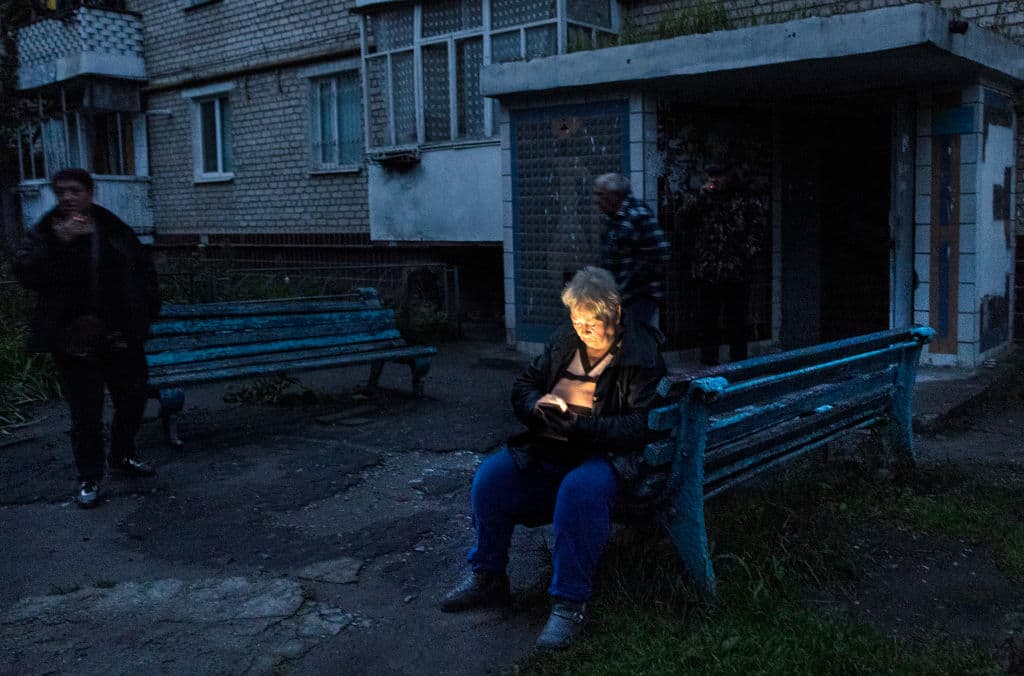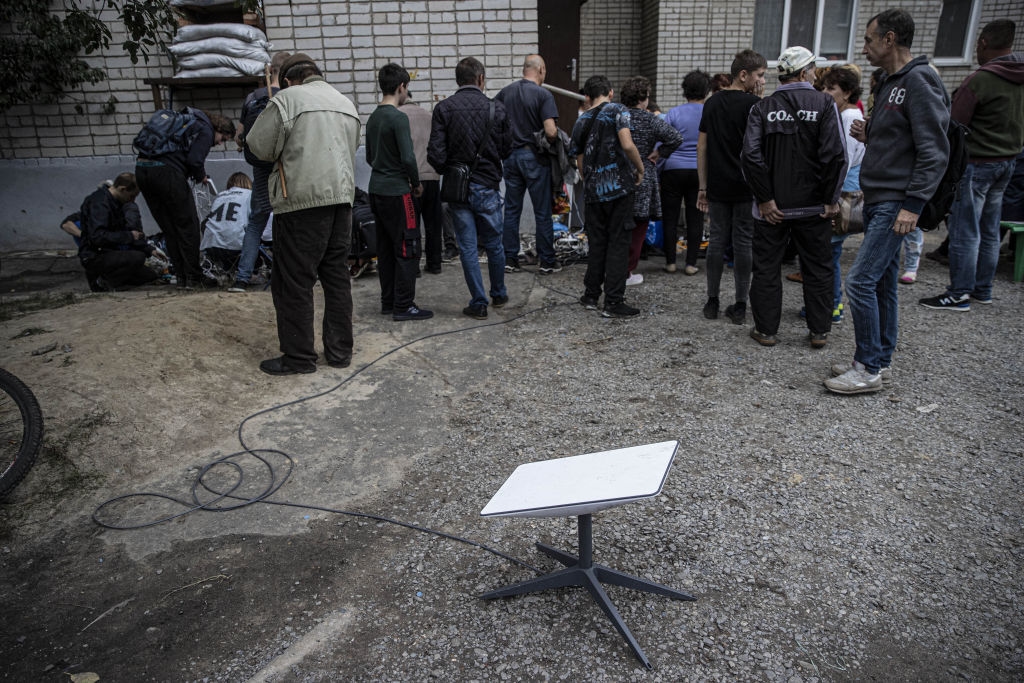People under Russian occupation cut off from internet, mobile connection

Editor’s Note: This story includes interviews with people living under Russian occupation. Their full names are not disclosed to protect their identity as they have shared sensitive information that could place them and their families in danger.
Every time Ukrainian engineer Yevhen wants to connect to the internet, he gets dressed and leaves the house to find one of the few public Wi-Fi hotspots in his town in southern Ukraine. The town, located not far from the port city of Mariupol, has been occupied by Russian forces since spring.
Like most people in his town, Yevhen doesn’t have the internet at home anymore. After Russia occupied the area, service from local Ukrainian internet providers was cut off, with the infrastructure either destroyed or captured by Russia.
The only option is to use the services of CityLine, one of the remaining local internet providers that now works through Russia-controlled telecom infrastructure.
The provider charges 50 Russian rubles a day to use its Wi-Fi hotspots, which must be paid for in cash. For those who lost their jobs and income under occupation, even this amount, less than $1 a day, is unaffordable.
Yevhen doesn’t use the internet every day – he tries to leave his home as rarely as possible to avoid being stopped and interrogated by Russian authorities.
When he finally gets online, Yevhen has to use VPN (a virtual private network) to get around blocks placed on many websites. Access to Facebook, Instagram, and Ukrainian news websites is blocked by Russia.
Ukrainian mobile carriers and TV channels are also almost completely inaccessible in the occupied territories.
Since the beginning of the full-scale invasion of Ukraine, Russia has continuously used the disruption of telecom services as a weapon. Cutting off Ukrainian internet providers, television and mobile connection creates an information blockade for Yevhen and millions of Ukrainians living under Russian occupation.
Under this blockade, it is much harder for Ukrainians to access independent media and communicate with relatives in other parts of Ukraine. The Kremlin is then able to fill this information void with its own propaganda, such as describing Russia’s full-scale invasion as “a liberation” and lying about what is actually happening on the battlefield.
The International Telecommunication Union (ITU), a United Nations agency that regulates global telecommunications, has been called upon to recommend sanctions on Russia for imposing its country code on the occupied Ukrainian territories and using Ukraine’s cellular frequencies.
However, despite Ukraine’s appeals, the ITU has not yet done so.
ITU responded to the Kyiv Independent’s press inquiry but did not provide specific answers to the questions.

Ukrainian citizens charge their mobile phones and tablets from a generator supplied by Ukrainian soldiers after Russian forces left Izium, Kharkiv Oblast, on Sept. 18.
Taking over internet
“The first thing the Russians do when they occupy Ukrainian territory is cut off the networks,” Stas Prybytko, head of mobile broadband development in Ukraine’s Ministry of Digital Transformation, told the Kyiv Independent.
Russian troops have destroyed or seized more than 4,000 base stations used by Ukrainian telecommunication operators and damaged more than 60,000 kilometers of fiber optic systems used to transmit internet signals, according to Ukraine’s Special Communications Service.
As of June, 15% of Ukraine’s internet infrastructure has been destroyed by the war, according to Communications Service.
Cutting off Ukrainian and introducing Russian mobile and internet coverage in the occupied territories is one of the first steps on the path to full annexation. This formula was already test-run in Crimea: after the annexation of the peninsula in 2014, Russia laid an underwater cable through the Kerch Strait to redirect internet traffic from occupied Crimea to Russia.
The necessity of access to communication helps Russian forces to impose a policy of “russification,” as connection can only be paid for in rubles, forcing people to use the Russian currency instead of the Ukrainian hryvnia.
One way to quickly switch Ukrainian users to a Russian-controlled internet is to seize the equipment of Ukrainian operators and reroute internet traffic through Russian networks, according to Oleksandr Arutiunian, board member of the Ukrainian Internet Association.
When internet connection is routed via Russia’s telecom infrastructure instead of Ukraine’s, it is usually subject to Russian internet regulations, surveillance, and censorship, according to internet monitoring firm NetBlocks.
Russian internet regulator Roskomnadzor also uses the internet to find and track opponents of Russian dictator Vladimir Putin and suppress independent information, according to an investigation by the New York Times.
Some Ukrainian internet providers that operated in the territories now occupied by Russia deliberately destroyed or disconnected their equipment so as not to turn it over to the invading troops.
Other providers choose to cooperate with Russians in order to not lose their business or to give people at least some connection. One of them is SkyNet, a local internet provider in Kherson, a southern Ukrainian city occupied by Russia since early March.
The departure from the region of Ukraine’s major internet providers, the destruction of telecom equipment, and constant power outages put a lot of pressure on SkyNet, according to its CEO Dmytro Gudz.
To keep working in Kherson, SkyNet switched its connection to Russian internet service provider Miranda Media which operates out of the occupied Crimea and is connected to Russian national telecom provider Rostelecom.
“There is simply no other alternative connection in the region apart from the Russian one,” Gudz said.
In a lengthy Facebook post published on May 4, Gudz, who lives in the occupied Kherson, said he understands that some Ukrainians see him as a Russian collaborator. Still, he’s not ashamed of switching to a Russia-controlled network.
“I helped tens of thousands of citizens,” he wrote. “It is very difficult to imagine an information vacuum, but as a person who has experienced it, I will tell you – it's scary when nothing works.”

Ukrainians line up on May 3 near the office of internet provider SkyNet in Kherson, a southern Ukrainian city occupied by Russia since early spring. To keep working in Kherson, Skynet switched to the Russian network Miranda Media in early May. (SkyNet Kherson / Facebook)
Controlling mobile networks
To control Ukraine’s mobile communication in the occupied territories, Russia forces people to obtain SIM cards from Kremlin-run mobile operators, including Phoenix and Lugacom, which are now working in occupied parts of Donetsk and Luhansk oblasts.
Ukraine doesn’t recognize these operators.
“They stole and reconfigured Ukrainian equipment and connected it to their own network,” according to Prybytko from the Ministry of Digital Transformation.
Those using Phoenix and Lugacom can’t call Ukrainian numbers — or any number in any country other than Russia, meaning that Ukrainians using these operators can’t call their friends and relatives in other parts of Ukraine.
Before the 2022 full-scale invasion, Phoenix and Lugacom had below 1.5 million subscribers, according to mobile security company Enea, but the exact number of their users is hard to estimate.
Around June, two brand new mobile providers – 7Telecom and MirTelecom – started operating in the occupied parts of Kherson and Zaporizhzhia oblasts.
In Kherson, MirTelecom uses seized equipment of Ukrainian telecom operators, including Kyivstar, Datagroup, Volia, and Vega, according to Gudz. Russian media reported in June that MirTelecom may be affiliated with the Russian Miranda Media, while 7Telecom is a subsidiary of K-Telecom, an internet provider active in occupied Crimea.
Both companies reportedly sell unbranded SIM cards with the +7 Russian country code, instead of the Ukrainian +380. The use of the Russian telephone code in occupied territories is a violation of a United Nations resolution, which rules against recognizing any changes in the status of these territories, according to the Special Communications Service of Ukraine.
When Russia started selling its SIM cards in Kherson in early June, thousands of Ukrainians lined up to buy them for lack of any alternative means of connection, according to Russian independent media outlet Novaya Gazeta.
In order to buy a SIM card with a Russian phone number, Ukrainians were forced to display their personal documents, which were photographed by Russian. This reflects Russian regulations, where one has to provide a passport to buy a SIM card.
Russian-installed proxies in Kherson were telling locals that Ukraine had cut the city off from communications, and that Russia is stepping in to restore the network.
Some Ukrainians were worried about being accused of treason for accepting Russian SIM cards, but they said they were desperate and wanted to finally get online to hear from their loved ones in other regions, according to Novaya Gazeta.

Ukrainian telecom workers repair broken internet infrastructure in Kharkiv Oblast. During the occupation of the parts of Kharkiv Oblast, the Russians stole equipment belonging to Ukrainian internet providers. (Mykhailo Fedorov / Telegram)
Restoring internet
Internet connection usually goes down when one of the three key network elements fails: optical cables, telecom towers, or electricity.
Whenever Ukraine liberates territories, like it did in the recent Kharkiv Oblast offensive, the country’s telecom operators immediately start working on restoring internet and cellular services.
Telecom operators, escorted by soldiers and emergency service workers, repair damaged communication lines in heavily shelled cities near the front line. For their efforts and courage, Ukraine's telecom technicians are often called "invisible heroes.”
One of Ukraine’s biggest internet providers, Datagroup, told the Kyiv Independent that it has already spent $1.3 million to restore more than 100 kilometers of its fiber optic lines damaged by Russian troops.
When there is no physical access to the destroyed infrastructure, they ask for help from local residents and the military.
“In one village, the locals built a new roof over our equipment to protect it from the rain,” said Victoria Pavlovskaya, spokeswoman for Ukrainian internet provider Vodafone. “Our engineers also taught the military to weld fiber optic lines to restore communication.”
Before the war, Ukrainian mobile operators created backup channels, which they use to redirect traffic when the main network is damaged or destroyed. This can even be achieved remotely, according to Pavlovskaya.
While operators clean up destroyed cell towers and build new ones, they use mobile base stations that work with Elon Musk’s satellite internet Starlink, according to Ukraine’s Minister of Digital Transformation Mykhailo Fedorov.
In April, Starlink helped Kyivstar, Vodafone, and lifecell to reconnect liberated towns in Kyiv Oblast, including Borodianka, Irpin, and Bucha, which were hit particularly hard by Russian attacks and suffered massive destruction.
Starlink is also helping Ukrainian telecom providers to restore communication in the liberated cities in the Kharkiv Oblast, including Balakliia and Izium.
More than 300 settlements near Kharkiv were without communication for months, according to Ukrainian telecom operators. Restoring infrastructure in these regions is difficult due to mines, constant shelling, and power outages, according to Prybytko. Telecom operators need to get permission from the military to start working in the region.
Russia’s war has devastated the finances of many local internet providers. Before the war, Kyiv-based internet provider Pautina had telecom infrastructure in Chernihiv, a city in northern Ukraine, which was under Russia’s siege in early spring. “We currently do not have the money to restore this network,” according to board member Arutiunian, who is also Pautina’s CEO.
Ukraine will need years and billions of dollars to restore its entire telecom infrastructure. As of July, the losses of the Ukrainian telecom market due to the war have reached $2.6 billion.
But as thousands of Ukrainian settlements remain under Russian control, many Ukrainians under occupation remain without any access to the internet and mobile services.
“Even the Russian provider Phoenix in Mariupol does not work well – the 4G network is only available in some places and works with interruptions,” Yevhen said.
Ukrainian CityLine, a local provider that decided to collaborate with Russian troops in occupied Mariupol, is struggling to restore the internet infrastructure in the heavily damaged city.
“It is impossible to restore networks that were built for 17 years in a few months,” a CityLine employee, who agreed to speak anonymously, told the Kyiv Independent.
For now, Yevhen and his neighbors will continue to regularly gather around a public Wi-Fi hotspot and pay Russian rubles to surf Russian websites – in the occupied Ukrainian town where just a few months back they all had uncensored internet at home.











